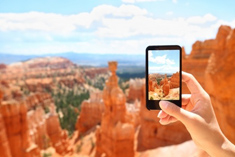"The best camera is the one you have with you," said photographer Elliott Erwitt. That may be why smartphones are so popular, stealing the show from classical cameras. This could hardly be due to their photographic quality… or could it?
The cameras integrated in smartphones fulfill all the prerequisites for bad photographs. Although technical writers have reason to assume that new developments in camera technology cannot overcome the basic laws of physics, the snapshot quality of current devices is impressive. Can these devices really be used for the challenging technical object photography in user manuals? The surprising result: Yes, it is possible, and with just a few limitations and attention to a few tips.
First, some basics
The sensor size and the quality of the lens play a crucial role in the quality of photographs using digital cameras. Manufacturers continually reduce both these parameters, primarily due to cost.
Physically, smaller sensor sizes lead to a smaller area per phototransistor (“pixel”) for the same number of megapixels. For instance, there is a difference of factor five in the pixel diameter ...
Read more after login
tekom members can log in directly with their "My tekom" access data.
You are not yet a tekom member, but would like to read one or more articles in full? Then you have the opportunity to register on the internet portal of the technical journal 'tcworld' without obligation. Once you have registered, you can select any three specialist articles and view them in full for a period of two months. The selection will then be deleted and you can select three new articles for the next two months.
As a tekom member you benefit from the following advantages::
- Online access to all articles of the trade magazine 'tcworld magazine'
- Exclusive specialist articles from all areas of technical communication
- Regular new articles from over 300 authors
- The technical journal 'tcworld magazine' as a printed edition
- Reduced admission prices to tekom conferences
- Membership fees for tekom publications
- Access to 'my tekom', the web forum with job offers / job requests, appointments, expert advice, service provider file and much more
Login
Registration
Promised: The trade magazine 'tcworld magazine' is the best we have. And we don't make the choice easy for ourselves. Every month, the editorial staff of the technical journal 'tcworld magazine' publishes the latest articles by renowned authors. This demanding selection is available exclusively to members of tekom (as usual, including the printed edition).
The trade magazine 'tcworld magazine' stands for intelligently prepared specialist articles, texts written to the point, informative content, surprising insights, international perspectives and communicates technical communication in an understandable, fast, clear and uncomplicated way - exclusively for you.

